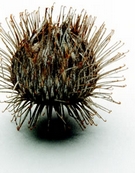Who Invented VELCROŽ brand?
 The Story of Hook & Loop
The Story of Hook & LoopClick here for VELCROŽ brand Sew On, VELCROŽ brand Coins, VELCROŽ brand Ties, VELCROŽ brand Self Adhesive, VELCROŽ brand Consumer Range
In the early 1900's as a small boy in Switzerland, George de Mestral loved two things- inventing and the outdoors.
George received his first patent at age 12 for designing a toy plane. A patent is a government grant that says only the inventor can make, sell or use his or her invention for a certain amount of time. George had a lot of success at a young age and decided he wanted to become an engineer, not the one who works on a train, but the one who designs new inventions.
After he was done with his studies, de Mestral took a job in the machine shop of a Swiss engineering company. He worked by day - but by night, he played with his machines.
As a person who was always outdoors, de Mestral was well aware Mother Nature is the best engineer of all. The burrs that stuck to his wool hunting pants and his dog's fur were annoying to him because of the amount of time it took to remove the pesky burrs. He also wondered why the burrs stuck. Looking at the burrs under a microscope, he noticed each burr consisted of hundreds of tiny hooks that "grabbed" into loops of thread or fur. Mother Nature had naturally made a fastener that was fool-proof! George de Mestral decided to take what Mother Nature had created to turn his idea into an everyday useful product. His idea interested a family friend, Alfred Gonet, who liked Mestral's idea.
De Mestral talked with fabric and cloth experts who worked with different types of woven and knit cloth in Lyon, France (which at the time was a worldwide center for weaving). Although the experts liked the idea of a hook and loop fastener, they were not sure if the idea would work. However, there was one expert who enjoyed challenges like de Mestral. Working on a small loom by hand, the weaver made two cotton tapes that, when pressed together, fastened just as strongly as Mother Nature's burrs.
In 1951, de Mestral applied for a patent (the government grant that says only the inventor can make, sell or use his or her invention for a certain amount of time) in Switzerland. In 1952, with the support of a company called Gonet & Co., de Mestral began a company called Velcro S.A. in Switzerland. Velcro S.A. received additional patents in Germany, Switzerland, Great Britain, Sweden, Italy, Holland, Belgium, France, Canada and the United States. These patents covered "the invention and fabrication of special napped piles of man-made material at least some of these loops having the means of hooking near their ends".
George de Mestral's invention is usually called "hook and loop tape." The "hook tape" has stiff little hooks on it, while the "loop tape" is soft and fuzzy. Together, they're called a "hook and loop fastener" or a "touch fastener."
So, what exactly is "VELCROŽ brand"? It is actually the name of a group of companies and it is a trademark owned by Velcro Industries, but it is not the hook and loop product itself. This means today, only the VELCROŽ brand companies make genuine VELCROŽ brand hook and loop fasteners, while other companies make hook and loop fasteners.
Questions and Answers
Q: Where did the word "VELCROŽ brand" come from?
A: From the French words for velvet, "velour", and hook, "crochet". Today, VELCROŽ brand products are manufactured in these countries: Canada, Mexico, Uruguay, China, Spain, Italy, Costa Rica, United States, and the United Kingdom.
VELCROŽ brand is a registered trademark of velcro industries B.V.




